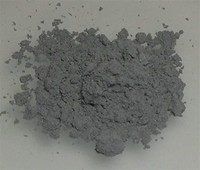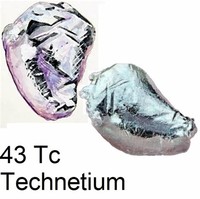Facts about Technetium

Klaus Schwochau's book Technetium lists 31 radiopharmaceuticals based on 99mTc for imaging and functional studies of the brain, myocardium, thyroid, lungs, liver, gallbladder, kidneys, skeleton, blood and tumors.

Pure metallic single-crystal technetium becomes a type II superconductor at 7.46 K; irregular crystals and trace impurities raise this temperature to 11.2 K for 99.9% pure technetium powder.

The fission of a gram of the rare isotope uranium-235 in nuclear reactors yields 27 mg of 99Tc, giving technetium a fission yield of 6.1 percent.

Extraterrestrial technetium was found in some red giant stars (S-, M-, and N-types) that contain an absorption line in their spectrum indicating the presence of this element.
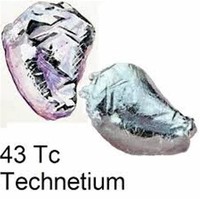
Technetium is a transition metal situated in group 7 (former group 7B) of the periodic table, between manganese and rhenium.

Other technetium isotopes are not produced in significant quantities by fission; when needed, they are manufactured by neutron irradiation of parent isotopes (for example, 97Tc can be made by neutron irradiation of 96Ru).

The primary hazard when working with technetium is inhalation of dust; such radioactive contamination in the lungs can pose a significant cancer risk.

The PUREX raffinate will contain a high concentration of technetium as TcO4- but almost all of this will be 99Tc.
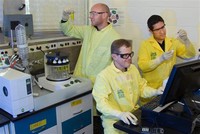
When one is working in a laboratory context, all isotopes of technetium must be handled carefully.

Technetium-99 has also been proposed for use in optolectric nuclear batteries.

Technetium plays no natural biological role and is not normally found in the human body.

The most common isotope, technetium-99, is a weak beta emitter; such radiation is stopped by the walls of laboratory glassware.

In 1999 David Curtis (see above) estimated that a kilogram of uranium contains 1 nanogram (1Ч10?9 g) of technetium.

The amount of artificially produced technetium in the environment exceeds its natural occurrence to a large extent.

In 1952 astronomer Paul W. Merrill in California detected the spectral signature of technetium (in particular, light at 403.1 nm, 423.8 nm, 426.8 nm, and 429.7 nm) in light from S-type red giants.

An estimated 160 TBq (about 250 kg) of technetium-99 was released into the environment up to 1994 by atmospheric nuclear tests.

Common oxidation states of technetium include 0, +2, +4, +5, +6 and +7.

Due to its high fission yield and relatively high half-life, technetium-99 is one of the main components of nuclear waste.

The long half-life of technetium-99 and its ability to form an anionic species makes it (along with 129I) a major concern when considering long-term disposal of high-level radioactive waste.

Several chemical extraction processes are used yielding technetium-99 metal of high purity.

On Earth, technetium occurs naturally only in uranium ores as a product of spontaneous fission or by neutron capture in molybdenum ores; the quantities are minute but have been measured.
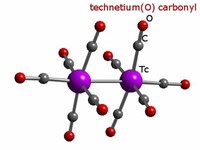
Technetium is one of the two elements in the first 82 that have no stable isotopes.

Their ability to reduce technetium may determine a large part of Tc's mobility in industrial wastes and other subsurface environments.

In 1962, technetium-99 was isolated and identified in pitchblende from the Belgian Congo in very small quantities (about 0.2 ng/kg); there it originates as a spontaneous fission product of uranium-238.

Technetium (chemical symbol Tc, atomic number 43) is a silvery gray, radioactive, crystalline metal.

The actual production of technetium-99 from spent nuclear fuel is a long process.

Technetium and promethium are remarkable among the light elements in that they have no stable isotopes.

Technetium-99 is the most common and most readily available isotope, as it is a major product of the fission of uranium-235.

Most technetium produced on Earth is a by-product of fission of uranium-235 in nuclear reactors and is extracted from nuclear fuel rods.

The radioactive nature of technetium (3 MBq per liter at the concentrations required) makes this corrosion protection impractical in almost all situations.

Under oxidizing conditions technetium (VII) will exist as the pertechnetate ion, TcO4-.

The University of Palermo researchers found the technetium isotope 97Tc in a sample of molybdenum given to Segrи by Ernest Lawrence the year before (Segrи visited Berkeley in the summer of 1936).

The metal form is slightly paramagnetic, meaning its magnetic dipoles align with external magnetic fields even though technetium is not normally magnetic.

The hospital then chemically extracts the technetium from the solution by using a technetium-99m generator ("technetium cow").

Below this temperature technetium has a very high magnetic penetration depth, the largest among the elements apart from niobium.

After sitting for several years, the radioactivity has fallen to a point where extraction of the long-lived isotopes, including technetium-99, becomes feasible.

Technetium-99 decays almost entirely by beta decay, emitting beta particles with very consistent low energies and no accompanying gamma rays.

